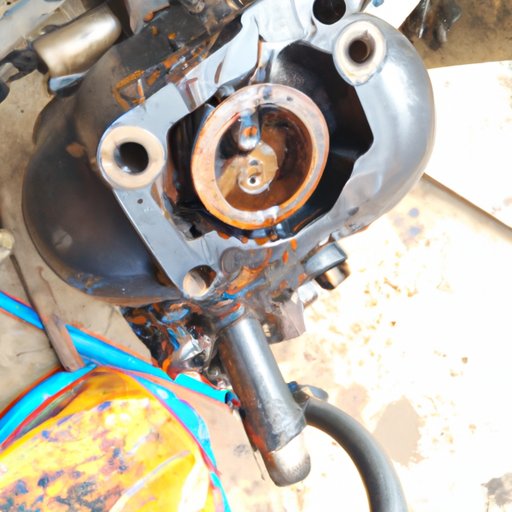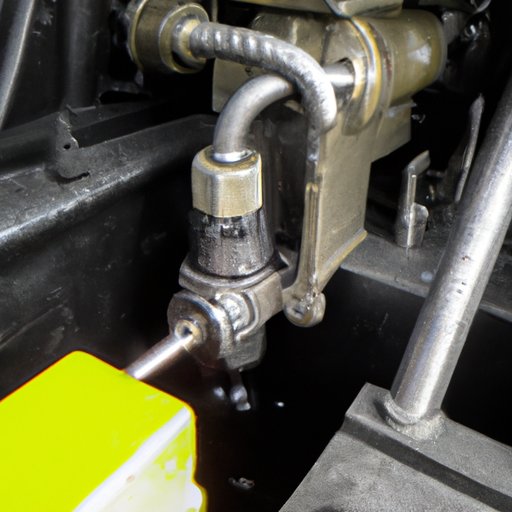Introduction
Hydraulic pumps are devices that are used in various industrial and agricultural applications. They are designed to convert mechanical energy into hydraulic energy by using fluid pressure and velocity to move liquids or other materials. In this article, we will explore how a hydraulic pump works and provide a step-by-step guide to understanding the science behind it.
Step-by-Step Guide to Understanding How a Hydraulic Pump Works
The first step to understanding how a hydraulic pump works is to explore the science behind it. Hydraulic pumps use fluid pressure and velocity to move liquids or other materials. The force of the liquid is transmitted through the piston, which acts as a plunger to push the material through the system. This creates a pressure differential between the high pressure side and the low pressure side of the system, allowing the material to flow.
An overview of the mechanism of a hydraulic pump can help to better understand its operation. In a basic hydraulic pump system, the piston is connected to a crankshaft which drives the movement of the piston. As the crankshaft rotates, the piston pushes and pulls the liquid, creating pressure differentials which drive the liquid throughout the system. This pressure differential is what allows the system to operate.
It is important to note that there are many different types of hydraulic pumps available, each with its own unique function. Some common types of hydraulic pumps include positive displacement pumps, gear pumps, vane pumps, and centrifugal pumps. Each type of hydraulic pump has its own set of principles for operation, so it is important to understand the specific requirements for each type before attempting any repair or maintenance work.
The Basics of How a Hydraulic Pump Operates
In order to understand how a hydraulic pump operates, it is important to familiarize yourself with the components of a hydraulic pump system. These components include the reservoir, the pump, the valves, and the actuator. The reservoir stores the fluid and is connected to the pump. The pump is responsible for moving the fluid through the system, and the valves regulate the flow of the fluid. Finally, the actuator is responsible for controlling the direction and speed of the fluid.
The principles of operation for different types of hydraulic pumps vary depending on the type of pump being used. Positive displacement pumps, for example, use the action of a set of internal pistons to draw in and pressurize the fluid. Gear pumps use rotating gears to create a vacuum, which draws in the fluid and then pumps it out under pressure. Vane pumps use a rotating rotor to draw in and pressurize the fluid, and centrifugal pumps use centrifugal force to draw in and pressurize the fluid.

Common Problems with Hydraulic Pumps and Solutions
As with any mechanical device, hydraulic pumps can experience common issues over time. Some of the most common issues associated with hydraulic pumps include leaks, clogs, and air bubbles. Leaks can occur due to worn seals or damaged hoses, and clogs can be caused by debris buildup or improper operation. Air bubbles can form when air enters the system, reducing the efficiency of the pump.
Fortunately, there are several steps that can be taken to address these common issues. Regular maintenance, such as inspecting the system for leaks and replacing worn parts, can help to prevent issues from occurring in the first place. Additionally, adjusting the operating parameters of the system, such as the flow rate, can help to reduce the risk of air bubbles forming in the system. Finally, using a specialized cleaning solution can help to remove debris that may be causing a clog.
Conclusion
In conclusion, understanding how a hydraulic pump works is essential for those who are looking to use one in their application. By exploring the science behind hydraulic pumps, as well as the components, principles of operation, and common issues associated with them, you can ensure that your hydraulic pump is operating efficiently and safely.
We hope that this article has provided you with a better understanding of how a hydraulic pump works. If you have any further questions or would like additional resources for further understanding, please seek out professional advice from an experienced technician.
(Note: Is this article not meeting your expectations? Do you have knowledge or insights to share? Unlock new opportunities and expand your reach by joining our authors team. Click Registration to join us and share your expertise with our readers.)
